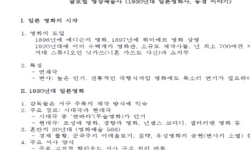This study tries to investigate the relation between maintone(sound)-composition of Isang Yun and formative arts. The first two chapter summerize the music historical primise for the integrative-artistic aesthetic and the process of establishment of I...
http://chineseinput.net/에서 pinyin(병음)방식으로 중국어를 변환할 수 있습니다.
변환된 중국어를 복사하여 사용하시면 됩니다.
- 中文 을 입력하시려면 zhongwen을 입력하시고 space를누르시면됩니다.
- 北京 을 입력하시려면 beijing을 입력하시고 space를 누르시면 됩니다.

조형예술의 측면에서 본 윤이상의 주요음(향)작곡 = The Maintone(Sound)-Composition of Isang Yun under the Aspect of Formative Arts
한글로보기https://www.riss.kr/link?id=A40132441
- 저자
- 발행기관
- 학술지명
- 권호사항
-
발행연도
2004
-
작성언어
-
- 주제어
-
KDC
600
-
등재정보
KCI등재
-
자료형태
학술저널
-
수록면
129-161(33쪽)
- 제공처
-
0
상세조회 -
0
다운로드
부가정보
다국어 초록 (Multilingual Abstract)
This study tries to investigate the relation between maintone(sound)-composition of Isang Yun and formative arts. The first two chapter summerize the music historical primise for the integrative-artistic aesthetic and the process of establishment of Isang Yuns identity as a composer in europe. Therby it is characteristic, that Yun is interested in the relation between music and pictures, while the western composers in the 1950s deal with graphical music and accidental music: the compositional situation tends to weaken the traditional note system, to expand the traditional instrumental medium, and to dismantle the traditional genre. The third chapter describes the relation between the formative image of west side in the acient tomb mural `Sasindo`, which is an about 1500 years old Korean traditional heritage. The line image of this mural is similar with the line image, which Yun draws in the dialog with the japanese composer Nishimura Akira about his maintone(sound)-model. An archetype of this line image is implemented in the beginning of the piece <flute-etu¨de>(1974) in the first section, and it is transformed in the beginning of the fifth section of the same work. Specially amorphous form ending of the maintone(sound)-model displays in this part an expanded form. The expansion of the amorphous form at the end of the maintone-model occurs also three times in <Re´ak>(1966). It is deduced, that this amorphous part form shaws alike in <Images> as a connecting part of the sound-surface. The last two chapter deal with the means of change the Korean traditional format image to modern sound. Yun saw always the picture of the mural in his living room and emphasized the line image of this picture in the explanations of his work, and draw this form in the air in the introduction of play. This phenomen is interpreted under two aspects: at one hand side, the image depicts the taoistic thouhgt, which Yun himself wont to identify with his work. On the other hand side, the connection of Yun`s music with a Korean traditional image shaws the fusion aspect of composer. The formative essence of maintone(sound) based on spatial form. The formative mean is created through tile fusion of the line and colorful images. This aura of an image is consistently and endless open. As a result, his maintone(sound) -composition can be interpret as a try to form of an Asian image in the real space `modern`.
동일학술지(권/호) 다른 논문
-
한국전통음악 장단연구에 나타나는 몇 가지 편향들에 대하여
- 한국음악학학회
- 이미경 ( Mi-GyeongLee )
- 2004
- KCI등재
-
창작국악의 비평적 담론(談論)에 대한 쟁점별 논고(論考)
- 한국음악학학회
- 이소영 ( Lee
- 2004
- KCI등재
-
일제강점기 음악의 사회사 -신문,잡지(1910-1945)를 중심으로
- 한국음악학학회
- 김창욱 ( Kim Chang Ug )
- 2004
- KCI등재
-
음악적 다다이스트에서 사회주의 리얼리스트로 나치수용소의 음악가 E. 슐호프에 관한 소고
- 한국음악학학회
- 이경분 ( Lee Gyeong Bun )
- 2004
- KCI등재




 KISS
KISS






